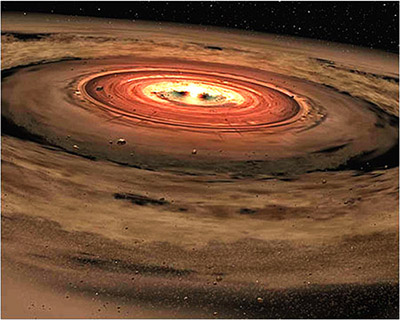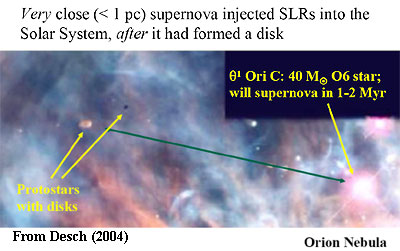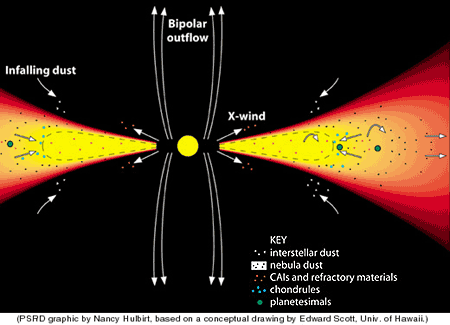The Neochaotian Era
Formation of the Solar System

Artist's Impression of Accretion Disc - NASA, via Essay Web
This page was originally the Cryptic Era of the Hadean page. With the new timescale proposed by Goldblatt et al. 2010 it becomes the the Titanomachean Period. The reason for these mythological names are explained in the previous page. As defined by Goldblatt et al. 2010:
"The Neochaotian Era begins with the first light from the Sun. Its periods are the Hyperitian (the Titan Sun god Hyperion) for the time when gravitational collapse made the Sun's first light brighter than its subsequent main sequence (Sackmann et al., 1993), followed by the Titanomachean (the war of Titans), to encompass the collision of proto-planets to form our present set of planets."
MAK110904
1. >n; 4567 Ma Supernova "Germinator" exploded causing a gravito-thermal collapse in the Sun Nebula (Eochaotian era)
2. ???? Ma The planetesimal system formed, soon giving rise to
- a number of protoplanets in the inner solar system, out to and including the current asteroid belt distance from Sun,
- the jovians Jupiter, Saturn, Neptune and Uranus, and
- the outer solar system icy planets (like Pluto).
in this era there were some 10-20 heavy FUor eruptions from Sun in its T Tauri stage, rising temperatures by 700? Kelvin; (Hyperitian period)
3. 4560 Ma For 10-30 Ma the inner solar system was characterized by protoplanet collisions and terrestrial planet formation: Mercury, Venus, Protogaia (protoearth), Theia and Mars. I've read one dating of Protogaia's formation to be 4557 Ma, which might be after Sun's T Tauri eruptions - this would then be one possible starting point of Hadean; most certainly Protogaia evolved some atmosphere soon after its creation. (Early Titanomachean)
4. 4533 Ma For a time after formation Protogaia was moonless, until Theia had grown to the size of current Mars. It is believed Theia was in Lagrange 4 coorbit (preceeding Trojan = same orbit but 30° forth) with Protogaia, but that position became unstable as Theia grew. Then Theia collided with Protogaia, and the major part became Earth, while some debris came in orbit around earth and assembled to Moon in some 10 years. It's very unclear whether this collision removed the atmosphere or not, some simulation numbers indicate a 50:50 probability whether removed or not removed. In either case the impact created a silicate atmosphere that is supposed to have cooled very fast (decades) (Later Titanomachean
rursus 061013
The Neochaotian (formerly Cryptic) Era encompasses the time during which the first 99% of the Earth's mass accreted from the solar disk. This interval began at 4567 Mya, the age of the oldest chondritic meteorites (essentially undifferentiated stardust). It ended when the Earth swallowed the hypothetical planetoid Theia (~4515 Mya), plus an allowance of 15 My for the Moon to form from all of the resulting debris which was not reabsorbed by the Earth. This brings us to the nice, round, even number of 4500 Mya, so that mathematical convenience and geological protocol are equally served.
The beginning of the solar system is one of the most accurately measured dates in astronomy. It is based on isotope ratios in the oldest meteorites which can confidently be ascribed to our own solar system. Those dates converge on 4560-4570 Mya with remarkable consistency. The meteorites are dated with the usual long-lived heavy-metal isotope ratios. We know that they date from near the beginning of the solar system because of the presence of other isotopes trapped by inclusions (individual grains) within the rock. These isotopes can only be produced from the decay of relatively short-lived radioactive materials (e.g. . Thus, the meteorite cannot be much younger than the solar system.
 Sounds good, but how did the short-lived radionuclides ("SLR"s) get there in the first place? There are several theories. The most popular seems to be that a supernova happened to explode in the galactic neighborhood at about the time the sun was turning on its fusion reactor. Supernovas produce most of the required SLRs, and the explosion inserted them into the protoplanetary disk. Other theories, relating to bursts of star formation within nebulae, explain why the presence of nearby supernova is not as coincidental as it might seem. Yet other ideas are put forward to explain why some ancient meteorites lack certain specific SLRs, how these materials were trapped in the disk, etc.
Sounds good, but how did the short-lived radionuclides ("SLR"s) get there in the first place? There are several theories. The most popular seems to be that a supernova happened to explode in the galactic neighborhood at about the time the sun was turning on its fusion reactor. Supernovas produce most of the required SLRs, and the explosion inserted them into the protoplanetary disk. Other theories, relating to bursts of star formation within nebulae, explain why the presence of nearby supernova is not as coincidental as it might seem. Yet other ideas are put forward to explain why some ancient meteorites lack certain specific SLRs, how these materials were trapped in the disk, etc.
In a very useful unpublished review, Desch (2004) notes that no single explanation accounts for all of the known SLRs in the early solar system. While Desch favors a close supernova (which reasonably explains the SLR types) he admits that the probability of a supernova just happening to be within ~3 light years of the system at just the right time is low. He asserts that this objection may be overcome if supernova events are also the cause of solar system formation, i.e. the supernova's shockwave induced collapse of the protoplanetary disk. However, as Desch states, no detailed models yet support the relationship between the death of one star with the birth of planets around another. In this connection it is important to remember that the supernova has to be within a few light-years, or all of the SLRs it produces will decay before they reach the protoplanetary disk. On the other hand, if the supernova is too  close, it will destroy the disk.
close, it will destroy the disk.
There are problems with the supernova hypothesis. If the supernova has to be the catalyst for condensation, then we'd expect that condensation of chondrites would occur at the same time as injection of SLRs. It turns out that most chondrite formation may have occurred a few My after SLRs were incorporated into solids. Wadhwa et al. 2007); Wadhwa & Russell (2000). Wadhwa's group (which includes Desch) sees all this as a process beginning with the supernova, but it complicates the relationship yet further. In addition, SLR relative abundances are not easily explained by a supernova. Gounelle et al. 2005). Even in the sort of nebulary scenario postulated by Desch and others, the probability of significant SLR accumulation from a supernova, without destroying the disk, is less than 1%. Williams & Gaidos (2007).
If we sound unconvinced about the supernova, it's only because we're unconvinced. It seems to involve quite a bit of special pleading. We therefore advance our own unconvincing idea. From a quick race through the literature, at least one factor may not have been taken into account. What happens when a star first ignites its fusion motor? Presumably, things go "boom" and the immediate neighborhood is cleared by a flood of photons. After this (a) the shock wave of photons ignites other regions, (b) the original area is quickly refilled as gravity reasserts itself, with the incoming particles creating a new and bigger "boom," or (c) some combination of the two.
 This sort of thing surely isn't like flipping on a light switch. Instead, the process seems rife with possibilities for locally non-linear effects, huge, fluctuating magnetic fields (Gounelle et al., 2005), and some briefly relativistic heavy ions. Take a look at the real protoplanetary clouds in the image. They are grossly asymmetric, inhomogeneous, and are associated with multiple, visible wave fronts, which are likewise lop-sided. Consider the magnitude of the forces necessary to generate this asymmetry against the homogenizing effects of gravity. In a few million years, these bodies will presumably settle down and raise their little solar systems like everyone else. But, during their fifteen minutes of flame, they clearly display -- locally and very briefly -- the ability to generate some remarkable pyrotechnics. In other words, for a short time, parts of the protosun might behave as a sort of amateur supernova.
This sort of thing surely isn't like flipping on a light switch. Instead, the process seems rife with possibilities for locally non-linear effects, huge, fluctuating magnetic fields (Gounelle et al., 2005), and some briefly relativistic heavy ions. Take a look at the real protoplanetary clouds in the image. They are grossly asymmetric, inhomogeneous, and are associated with multiple, visible wave fronts, which are likewise lop-sided. Consider the magnitude of the forces necessary to generate this asymmetry against the homogenizing effects of gravity. In a few million years, these bodies will presumably settle down and raise their little solar systems like everyone else. But, during their fifteen minutes of flame, they clearly display -- locally and very briefly -- the ability to generate some remarkable pyrotechnics. In other words, for a short time, parts of the protosun might behave as a sort of amateur supernova.
The recent literature contains some thought in this direction, e.g., Gounelle et al. 2005) ("X-wind" model). Unfortunately, this model does not account for the presence of 60Fe, for which the authors concede a supernova origin. Desch 2004) argues that these kinds of forces would also exhaust themselves quickly ionizing gas, rather than causing nuclear reactions. But this effect might also raise the possibility of wakefield acceleration, which would produce a proportion of even higher energy particles.
Other Image Credits: Protosuns from the Physics 108 website of Prof. Joseph Howard, Salisbury Univ. (MD, USA). X-wind graphic from Planetary Science Research Discoveries.
The bulk of the sun's protoplanetary disk condensed from gas and dust into rock in only 2-3 My. Bizzarro et al. (2004). The inner planets are thought to have accreted in about 30 My, and perhaps much less. Krot et al. (2005). Baker et al. (2005) report absolute dates from basaltic meteorites within 1-2 My of the formation of the solar system, i.e. 4566.2 ± 0.1 My. Note that this is basalt, not some undifferentiated chondrite. It necessarily came from a sizeable body which had generated large internal pressures and was beginning to separate into different rock layers.
 After that, things were kept lively for another 30 My or so by impacts between the inner planets and a few remaining planetoids, such as the Earth-Theia collision. For the most part, these late encounters added no net mass to the inner planets. The bodies involved were probably still molten. Greenwood et al. (2005). The relatively large tidal forces exerted by the existing planets simply ripped the impactors apart and threw the remains out of the inner solar system. Massed gained from the planetoids was offset by mass lost to space from the force of the impact. The formation of our own moon was a relatively unusual event. Simulations show that impacts (or near misses) in this era had about an even chance of reducing planetary masses by shaving off pieces of the planet during glancing collisions. Asphaug et al. 2006).
After that, things were kept lively for another 30 My or so by impacts between the inner planets and a few remaining planetoids, such as the Earth-Theia collision. For the most part, these late encounters added no net mass to the inner planets. The bodies involved were probably still molten. Greenwood et al. (2005). The relatively large tidal forces exerted by the existing planets simply ripped the impactors apart and threw the remains out of the inner solar system. Massed gained from the planetoids was offset by mass lost to space from the force of the impact. The formation of our own moon was a relatively unusual event. Simulations show that impacts (or near misses) in this era had about an even chance of reducing planetary masses by shaving off pieces of the planet during glancing collisions. Asphaug et al. 2006).
The fact that these large Late Titanomachean collisions were both random and rare does have significant implications for properties other than mass. Large collisions would strip off the earliest atmospheres, might change the composition of the crust, alter the crust:core ratio, and change the spin rate and axis of the planet, all depending on the properties of the impacting planetoids. Halliday (2004); Koeberl (2006). The net result of is that the inner planets show considerably more random variability than one might expect. Canup & Agnor (2000). ATW070724
last modified ATW070724, MAK110904, rursus 061013, edited RFVS111024
Text by MAK and Rursus is Creative Commons Attribution License), text by ATW is public domain, no rights reserved. Images are copyright their respective sources or, in the case of NASA images, public domain
 Sounds good, but how did the short-lived radionuclides ("SLR"s) get there in the first place? There are several theories. The most popular seems to be that a supernova happened to explode in the galactic neighborhood at about the time the sun was turning on its fusion reactor. Supernovas produce most of the required SLRs, and the explosion inserted them into the protoplanetary disk. Other theories, relating to bursts of star formation within nebulae, explain why the presence of nearby supernova is not as coincidental as it might seem. Yet other ideas are put forward to explain why some ancient meteorites lack certain specific SLRs, how these materials were trapped in the disk, etc.
Sounds good, but how did the short-lived radionuclides ("SLR"s) get there in the first place? There are several theories. The most popular seems to be that a supernova happened to explode in the galactic neighborhood at about the time the sun was turning on its fusion reactor. Supernovas produce most of the required SLRs, and the explosion inserted them into the protoplanetary disk. Other theories, relating to bursts of star formation within nebulae, explain why the presence of nearby supernova is not as coincidental as it might seem. Yet other ideas are put forward to explain why some ancient meteorites lack certain specific SLRs, how these materials were trapped in the disk, etc.


